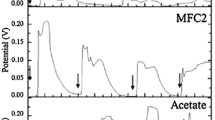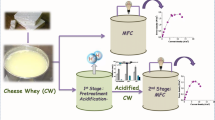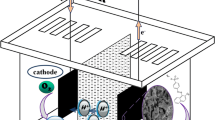Abstract
Kefir, a combined consortium of bacteria and yeast encapsulated by a polymeric matrix of exopolysaccharides, was used as anodic biocatalyst in a two-chamber microbial fuel cell (MFC). Fermentation was followed during 72 h and polarization curves were obtained from linear sweep voltammetry. The effect of methylene blue as charge-transfer mediator in the kefir metabolism was evaluated. UV/Vis spectrophotometry and cyclic voltammetry were applied to evaluate the redox state of the mediator and to characterize the electrochemical activity, whereas current interruption was used for internal resistance determination. Aiming to establish a relationship between the microbial development inside the anodic chamber with the generated power in the MFC, total titratable acidity, pH, viscosity, carbohydrate assimilation, and microbial counting were assayed. The kefir-based MFC demonstrated a maximum power density of 54 mW m−2 after 24 h fermentation, revealing the potential use of kefir as a biocatalyst for microbial fuel cells.






Similar content being viewed by others
References
Shleev, S., Bergel, A., & Gorton, L. (2015). Biological fuel cells: divergence of opinion. Bioelectrochemistry, 106(Pt A), 1–2.
Rosenbaum, M., Aulenta, F., Villano, M., & Angenent, L. T. (2011). Cathodes as electron donors for microbial metabolism: which extracellular electron transfer mechanisms are involved? Bioresource Technology, 102(1), 324–333.
Hubenova, Y., & Mitov, M. (2015). Extracellular electron transfer in yeast-based biofuel cells: a review. Bioelectrochemistry, 106(Pt A), 177–185.
Schröder, U. (2007). Anodic electron transfer mechanisms in microbial fuel cells and their energy efficiency. Physical Chemistry Chemical Physics, 9(21), 2619–2629.
Jia, B., Hu, D., Xie, B., Dong, K., & Liu, H. (2013). Increased power density from a spiral wound microbial fuel cell. Biosensors and Bioelectronics, 41, 894–897.
Huang, Y., He, Z., Kan, J., Manohar, A. K., Nealson, K. H., & Mansfeld, F. (2012). Electricity generation from a floating microbial fuel cell. Bioresource Technology, 114, 308–313.
Du, Z., Li, H., & Gu, T. (2007). A state of the art review on microbial fuel cells: a promising technology for wastewater treatment and bioenergy. Biotechnology Advances, 25(5), 464–482.
Li, W.-W., Sheng, G.-P., Liu, X.-W., & Yu, H.-Q. (2011). Recent advances in the separators for microbial fuel cells. Bioresource Technology, 102(1), 244–252.
Ahmad, F., Atiyeh, M. N., Pereira, B., & Stephanopoulos, G. N. (2013). A review of cellulosic microbial fuel cells: performance and challenges. Biomass and Bioenergy, 56, 179–188.
Wolińska, A., Stępniewska, Z., Bielecka, A., & Ciepielski, J. (2014). Bioelectricity production from soil using microbial fuel cells. Applied Biochemistry and Biotechnology, 173(8), 2287–2296.
Rabaey, K., Boon, N., Siciliano, S. D., Verhaege, M., & Verstraete, W. (2004). Biofuel cells select for microbial consortia that self-mediate electron transfer. Applied and Environmental Microbiology, 70(9), 5373–5382.
Arslan, S. (2015). A review: chemical, microbiological and nutritional characteristics of kefir. CyTA - Journal of Food, 13(3), 340–345.
Marsh, A. J., O’Sullivan, O., Hill, C., Ross, R. P., & Cotter, P. D. (2013). Sequencing-based analysis of the bacterial and fungal composition of kefir grains and milks from multiple sources. PLoS One, 8(7), 1–11.
Zanirati, D. F., Abatemarco, M., Sandes, S. H. d. C., Nicoli, J. R., Nunes, Á. C., & Neumann, E. (2015). Selection of lactic acid bacteria from Brazilian kefir grains for potential use as starter or probiotic cultures. Anaerobe, 32, 70–76.
Gao, J., Gu, F., He, J., Xiao, J., Chen, Q., Ruan, H., & He, G. (2013). Metagenome analysis of bacterial diversity in Tibetan kefir grains. European Food Research and Technology, 236(3), 549–556.
Witthuhn, R. C., Schoeman, T., & Britz, T. J. (2004). Isolation and characterization of the microbial population of different South African kefir grains. International Journal of Dairy Technology, 57(1), 33–37.
Freguia, S., Masuda, M., Tsujimura, S., & Kano, K. (2009). Lactococcus lactis catalyses electricity generation at microbial fuel cell anodes via excretion of a soluble quinone. Bioelectrochemistry, 76(1–2), 14–18.
Karthikeyan, R., Krishnaraj, N., Selvam, A., Wong, J. W.-C., Lee, P. K. H., Leung, M. K. H., & Berchmans, S. (2016). Effect of composites based nickel foam anode in microbial fuel cell using Acetobacter aceti and Gluconobacter roseus as a biocatalysts. Bioresource Technology, 217, 113–120.
Kaneshiro, H., Takano, K., Takada, Y., Wakisaka, T., Tachibana, T., & Azuma, M. (2014). A milliliter-scale yeast-based fuel cell with high performance. Biochemical Engineering Journal, 83, 90–96.
Ganguli, R., & Dunn, B. S. (2009). Kinetics of anode reactions for a yeast-catalysed microbial fuel cell. Fuel Cells, 9(1), 44–52.
Sayed, E. T., Tsujiguchi, T., & Nakagawa, N. (2012). Catalytic activity of baker’s yeast in a mediatorless microbial fuel cell. Bioelectrochemistry, 86, 97–101.
Schneedorf, J. M. (2012). Kefir D’Aqua and its probiotic properties. In E. Rigobelo (Ed.), Probiotic in animals. InTech. pp. 53–76.
Bergmann, R. S. d. O., Pereira, M. A., Veiga, S. M. O. M., Schneedorf, J. M., Oliveira, N. d. M. S., & Fiorini, J. E. (2010). Microbial profile of a kefir sample preparations: grains in natura and lyophilized and fermented suspension. Food Science and Technology (Campinas), 30(4), 1022–1026.
Logan, B. E., Hamelers, B., Rozendal, R., Schröder, U., Keller, J., Freguia, S., Aelterman, P., Verstraete, W., & Rabaey, K. (2006). Microbial fuel cells: methodology and technology. Environmental Science & Technology, 40(17), 5181–5192.
BRASIL. Ministério da Agricultura. Portaria n° 76 de 26 de novembro de 1986. Dispõe sobre os métodos analíticos de bebidas e vinagre. Diário Oficial da República Federativa do Brasil, Brasília, 28 nov. 1986. Seção 1, pt. 2.
Vasconcelos, N. M., Pinto, G. A. S., Aragão, F. A. S. (2007). Determinação de Açúcares Redutores pelo Ácido 3, 5-Dinitrosalicílico: Histórico do Desenvolvimento do Método e Estabelecimento de um Protocolo para o Laboratório de Bioprocessos; Boletim de Pesquisa e desenvolvimento, 88, 1-22; Sucrose assay with DNS. Available from: http://eng.umd.edu/~nsw/ench485/lab9d.htm. Accessed 18 May 2017.
Akeson, W. R., Gorz, H. J., & Haskins, F. A. (1969). Sweetclover weevil feeding stimulants: isolation and identification of glucose, fructose, and sucrose. Crop Science, 9(6), 810–812.
Buchan, J. L., & Savage, R. I. (1952). Paper chromatography of some starch conversion products. Analyst, 77(917), 401–406.
Thomas, P., Sekhar, A. C., Upreti, R., Mujawar, M. M., & Pasha, S. S. (2015). Optimization of single plate-serial dilution spotting (SP-SDS) with sample anchoring as an assured method for bacterial and yeast cfu enumeration and single colony isolation from diverse samples. Biotechnology Reports, 8, 45–55.
Babanova, S., Hubenova, Y., & Mitov, M. (2011). Influence of artificial mediators on yeast-based fuel cell performance. Journal of Bioscience and Bioengineering, 112(4), 379–387.
Aelterman, P., Rabaey, K., Pham, H. T., Boon, N., & Verstraete, W. (2006). Continuous electricity generation at high voltages and currents using stacked microbial fuel cells. Environmental Science & Technology, 40(10), 3388–3394.
Karthikeyan, R., Sathish kumar, K., Murugesan, M., Berchmans, S., & Yegnaraman, V. (2009). Bioelectrocatalysis of Acetobacter aceti and Gluconobacter roseus for current generation. Environmental Science & Technology, 43(22), 8684–8689.
Hubenova, Y., & Mitov, M. (2010). Potential application of Candida melibiosica in biofuel cells. Bioelectrochemistry, 78(1), 57–61.
Hidalgo, D., Tommasi, T., Cauda, V., Porro, S., Chiodoni, A., Bejtka, K., & Ruggeri, B. (2014). Streamlining of commercial Berl saddles: a new material to improve the performance of microbial fuel cells. Energy, 71, 615–623.
Watson, V. J., & Logan, B. E. (2011). Analysis of polarization methods for elimination of power overshoot in microbial fuel cells. Electrochemistry Communications, 13(1), 54–56.
Ieropoulos, I., Winfield, J., & Greenman, J. (2010). Effects of flow-rate, inoculum and time on the internal resistance of microbial fuel cells. Bioresource Technology, 101(10), 3520–3525.
Winfield, J., Ieropoulos, I., Greenman, J., & Dennis, J. (2011). The overshoot phenomenon as a function of internal resistance in microbial fuel cells. Bioelectrochemistry, 81(1), 22–27.
Nien, P.-C., Lee, C.-Y., Ho, K.-C., Adav, S. S., Liu, L., Wang, A., Ren, N., & Lee, D.-J. (2011). Power overshoot in two-chambered microbial fuel cell (MFC). Bioresource Technology, 102(7), 4742–4746.
Bard, A. J., & Faulkner, L. R. (2001). Electrochemical methods: fundamentals and applications (2nd ed.). Wiley: New York.
Jung, S., & Regan, J. M. (2011). Influence of external resistance on electrogenesis, methanogenesis, and anode prokaryotic communities in microbial fuel cells. Applied and Environmental Microbiology, 77(2), 564–571.
Hubenova, Y., Bakalska, R., Hubenova, E., & Mitov, M. (2016). Mechanisms of electron transfer between a styrylquinolinium dye and yeast in biofuel cell. Bioelectrochemistry, 112, 158–165.
Rasmussen, M., & Minteer, S. D. (2015). Long-term arsenic monitoring with an Enterobacter cloacae microbial fuel cell. Bioelectrochemistry, 106(Pt A), 207–212.
Silveira, G., Ikegaki, M., & Schneedorf, J. M. (2017). A low-cost yeast-based biofuel cell: an educational green approach. Green Chemistry Letters and Reviews, 10(1), 32–41.
Yang, W., Li, J., Ye, D., Zhang, L., Zhu, X., & Liao, Q. (2016). A hybrid microbial fuel cell stack based on single and double chamber microbial fuel cells for self-sustaining pH control. Journal of Power Sources, 306, 685–691.
Lide, D. R., et al. (2004). CRC handbook of chemistry and physics (84th ed.). CRC Press: New York.
Braithwaite, A., & Smith, J. F. (1999). Chromatographic methods (5th ed.). Kluwer Academic Publishers: Dordrecht.
Sturm, A. (1999). Invertases. Primary structures, functions, and roles in plant development and sucrose partitioning. Plant Physiology, 121(1), 1–8.
Laureys, D., & De Vuyst, L. (2014). Microbial species diversity, community dynamics, and metabolite kinetics of water kefir fermentation. Applied and Environmental Microbiology, 80(8), 2564–2572.
Corona, O., Randazzo, W., Miceli, A., Guarcello, R., Francesca, N., Erten, H., Moschetti, G., & Settanni, L. (2016). Characterization of kefir-like beverages produced from vegetable juices. LWT - Food Science and Technology, 66, 572–581.
Magalhães, K. T., Pereira, G. V. d. M., Campos, C. R., Dragone, G., & Schwan, R. F. (2011). Brazilian kefir: structure, microbial communities and chemical composition. Brazilian Journal of Microbiology, 42(2), 693–702.
Fiorda, F. A., de Melo Pereira, G. V., Thomaz-Soccol, V., Medeiros, A. P., Rakshit, S. K., & Soccol, C. R. (2016). Development of kefir-based probiotic beverages with DNA protection and antioxidant activities using soybean hydrolyzed extract, colostrum and honey. LWT - Food Science and Technology, 68, 690–697.
Ribeiro, E. S., Rosatto, S. S., Gushikem, Y., & Kubota, L. T. (2003). Electrochemical study of Meldola’s blue, methylene blue and toluidine blue immobilized on a SiO2/Sb2O3 binary oxide matrix obtained by the sol-gel processing method. Journal of Solid State Electrochemistry, 7(10), 665–670.
Rigoulet, M., Aguilaniu, H., Avéret, N., Bunoust, O., Camougrand, N., Grandier-Vazeille, X., Larsson, C., Pahlman, I.-L., Manon, S., & Gustafsson, L. (2004). Organization and regulation of the cytosolic NADH metabolism in the yeast Saccharomyces cerevisiae. Molecular and Cellular Biochemistry, 256(1), 73–81.
Altay, F., Karbancıoglu-Güler, F., Daskaya-Dikmen, C., & Heperkan, D. (2013). A review on traditional Turkish fermented non-alcoholic beverages: microbiota, fermentation process and quality characteristics. International Journal of Food Microbiology, 167(1), 44–56.
Min, B., Román, Ó. B., & Angelidaki, I. (2008). Importance of temperature and anodic medium composition on microbial fuel cell (MFC) performance. Biotechnology Letters, 30(7), 1213–1218.
Ju, H., Zhou, J., Cai, C., & Chen, H. (1995). The electrochemical behavior of methylene blue at a microcylinder carbon fiber electrode. Electroanalysis, 7(12), 1165–1170.
Hasnat, M. A., Safwan, J. A., Islam, M. S., Rahman, Z., Karim, M. R., Pirzada, T. J., Samed, A. J., & Rahman, M. M. (2015). Electrochemical decolorization of methylene blue at Pt electrode in KCl solution for environmental remediation. Journal of Industrial and Engineering Chemistry, 21, 787–791.
Lee, S.-K., & Mills, A. (2003). Novel photochemistry of leuco-methylene blue. Chemical Communications, (18), 2366–2367.
da Silva, J. S., Junqueira, H. C., & Ferreira, T. L. (2014). Effect of pH and dye concentration on the n-octanol/water distribution ratio of phenothiazine dyes: a microelectrode voltammetry study. Electrochimica Acta, 144, 154–160.
Acknowledgements
The authors wish to acknowledge Federal University of Alfenas, Minas Gerais, Brazil, for the facilities provided to accomplish the present research. We thank Dr. Masaharu Ikegaki for your careful reading of the manuscript and helpful comments and suggestions.
Author information
Authors and Affiliations
Corresponding author
Ethics declarations
Conflict of Interest
The authors declare that they have no conflict of interest.
Electronic Supplementary Material
Fig. S1
a Cyclic voltammograms of the MFC anolyte containing methylene blue at 0.48 × 10−3 mol L−1 after 48 h fermentation. Scan rates of 0.010, 0.025, 0.050, 0.075, 0.100, 0.200, 0.300, and 0.400 V s−1. Conditions: working electrode, Pt disk; counter electrode, Pt wire; reference electrode, Ag/AgCl (saturated KCl); potential range from − 400 to + 300 mV. b Peak currents vs. square root of the scan rate (0.010–0.4 V s−1). R2 > 0.992 for all the fixed intervals. (PDF 88 kb)
Fig. S2
Paper chromatogram from samples collected at different MFC operating times. Lanes: 1–3 (0 h); 4–6 (24 h); 7–9 (48 h); 10–12 (72 h). The samples at points 3, 6, 9, 12 were collected from MFC without the mediator. Reference compounds: sucrose (S); glucose (G); fructose (F). (PDF 812 kb)
Rights and permissions
About this article
Cite this article
Silveira, G., Schneedorf, J.M. Evaluation of Kefir as a New Anodic Biocatalyst Consortium for Microbial Fuel Cell. Appl Biochem Biotechnol 185, 1118–1131 (2018). https://doi.org/10.1007/s12010-018-2718-2
Received:
Accepted:
Published:
Issue Date:
DOI: https://doi.org/10.1007/s12010-018-2718-2




